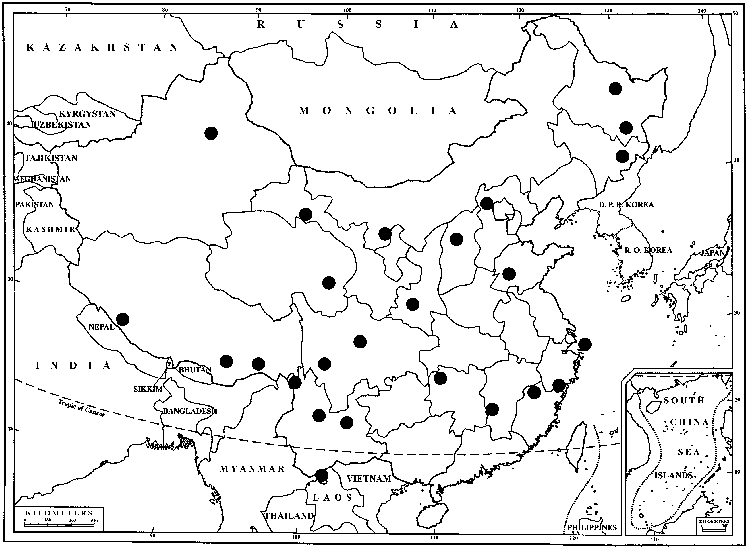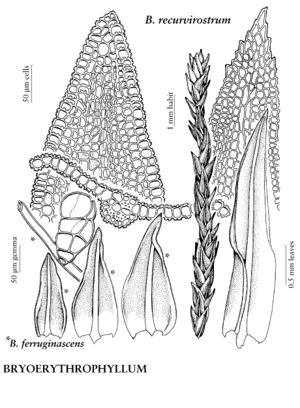Bryoerythrophyllum recurvirostrum
Hedwigia 80: 5. 1941,.
Stems often short, but to 2 cm in sterile plants. Stem-leaves oblong-lanceolate to longlanceolate, occasionally ovate, mostly 1.5–3.5 mm, distal lamina 1-stratose, margins recurved in proximal 3/4 of leaf or to apex, entire or 1–3 toothed at apex, acute to broadly acute apically; costa percurrent or ending 1–4 cells before the apex, not much widened or tapering, usually 4–6 epidermal-cells wide at mid leaf, adaxial surface of the costa weakly convex or concave; proximal leaf cells rectangular throughout the sheathing base, those in 1–4 marginal rows often narrow, the medial cells usually 3–4: 1. Specialized asexual reproduction absent. Sexual condition synoicous, paroicous, polygamous or rhizautoicous. Capsule theca 0.8–2.2 mm, operculum 0.3–1 mm, peristome teeth 16, irregularly cleft, 100–220 µm or occasionally rather short, smooth. Spores 14–17 µm.
Phenology: Capsules mature summer–fall (Jun–Sep).
Habitat: Soil, rock (limestone, dolomite, gypsum, siliceous), mortar of wall, bark, in tussock tundra, alpine meadows, bluffs, forested and boggy areas, stream banks, lake shores
Elevation: low to high elevations (20-3800 m)
Distribution

Greenland, Alta., B.C., Man., N.B., Nfld. and Labr., N.W.T., N.S., Nunavut, Ont., Que., Yukon, Alaska, Ariz., Colo., Conn., Idaho, Iowa, Mich., Minn., Mont., Nebr., Nev., N.Y., Oreg., S.Dak., Utah, Vt., Wash., Wis., Wyo., Mexico, Central America, n South America, Eurasia, Africa, Pacific Islands (New Zealand), Australia
Discussion
Bryoerythrophyllum recurvirostrum may be mistaken for Trichostomum crispulum, which may be reddish in color and which usually has a chestnut red costa; the latter species is distinguished by its cucullate leaf apex and plane margins. The former is also immediately distinguishable at low magnification from Didymodon vinealis and D. asperifolius, both plants reddish in basal parts, by its green distal leaves and the whitish, glistening, rather enlarged but not particularly sharply differentiated basal cells. The peristome is usually short and yellowish but may be rudimentary or occasionally absent even in specimens with a long-rostrate operculum. The annulus of B. recurvirostrum is variably revoluble or deciduous in pieces. This species is remarkably variable in length of leaf, but the width of the leaf does not vary greatly, thus short leaves are oblong-lanceolate and longer ones are long-lanceolate. Strongly dentate distal leaf margins are plane, but the marginal teeth distinguish this species from similar taxa in the flora area with plane but entire distal margins. Specimens originally assigned to var. brevifolium and var. latinervium are here submerged. The short-leaved form, which may often have rather rounded, only occasionally apiculate apices, intergrades with the more common morphotype. Variety latinervium differs from most specimens of the typical variety by the dense, spirally laid leaves, rather broad costa, to 8 cells wide (200–250 µm), and the broadly revolute margins. Intergrades exist, however. A sterile specimen from Alaska (Murray 10987, ALA) has rounded leaf apices with a clearly subpercurrent, broad costa and short, triangular leaves, being in appearance similar to B. rotundata (Lindberg & Arnell) P. C. Chen of Asia; however, some leaves of the Alaskan collection are weakly apiculate, and the specimen is therefore included here.
I agree with W. C. Steere (1938) that large specimens with lamina beyond mid leaf plane and dentate (P. M. Eckel 1990b) intergrade (e.g., Alaska, Worley 6248, DUKE) completely with the typical variety. The British Columbia specimen (Schofield 15257, CAN) originally identified as Bryoerythrophyllum alpigenum but referred to B. jamesonii (Taylor) H. A. Crum by R. H. Zander (1978g) is a long-leaved variant with leaves plane and dentate in the distal half as in what has been referred to as var. dentatum, but also has the rather narrow and not sharply differentiated proximal cells of B. jamesonii (Taylor) H. A. Crum, an essentially Latin American species; but because the British Columbia specimen and others like it are much outside the range of the latter, are sterile (the last latter is dioicous), and occur in an hyperoceanic area known for taxon variants of large stature, it is best taken as a large form of B. recurvirostrum.
Bryoerythrophyllum recurvirostrum is generally synoicous or paroicous, but antheridia may not be present in every inflorescence. There is a great range of variation in sexuality in this species. Occasionally small male buds may be present on soil at the base of stems (e.g., Manitoba, Crum et al. 65c, CAN), indicating rhizautoicy. Some superficially dioicous specimens have distinctive broad leaf apices and nearly plane margins, but plants with typical leaves with narrow apicies and long-recurved margins may also exhibit rhizautoicy. One subarctic specimen (Ontario, Kenora District, Polar Bear Park, Williams 4022, CAN) was autoicous (as described for the species in general by E. Lawton (1971), another from Colorado (Weber, Kunkel & Munger B-46226, MO) was definitely cladautoicous, while one from Arizona (Haring 12262, MO) had both typically synoicous inflorescences and gemmate perigonia as has the var. aeneum (Müller Hal.) R. H. Zander of Mexico, but lacked the characteristic rhizoidal brood bodies of that taxon.
Selected References
None.
